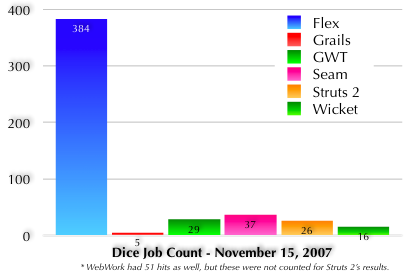Tonight I'm in Mountain View attending the inaugural meeting for the new Silicon Valley Google Technology User Group (SV-GTUG). The good news about this meeting is Bob plans to discuss some of the new features in the GWT 1.5
release. Although it is not available yet, it sounds like they are putting the finishing touches on the 1.5 release and that it will be available soon.
The first ting I've learned is that GWT is actually pronounced "gwit". Bob is a member of the GWT team and he's the only one that's not based out of Atlanta. GWT has a very Swing-like programming model. It has widgets, panels and windows and operates very much like a traditional UI programming API. To create an application, you create a class that implements EntryPoint . Below is an example Hello World application.
. Below is an example Hello World application.
/**
* HelloWorld application.
*/
public class Hello implements EntryPoint {
public void onModuleLoad() {
Button b = new Button("Click me", new ClickListener() {
public void onClick(Widget sender) {
Window.alert("Hello, AJAX");
}
});
RootPanel.get().add(b);
}
}
|
One of the really nice things about GWT is that you can easily debug your application in your favorite Java IDE. GWT doesn't prevent you from writing JavaScript - you can insert native JavaScript into your code using a special /*-{ script here }-*/.
When you compile a GWT application, you get a whole bunch of stuff. When trying to develop cross-browser JavaScript code, you often end up with "if soup" to handle the different browsers. GWT does the same thing, but it creates different versions of the application for the different browsers. The naming of these files is an MD5 hash that's bootstrapped by a simple JS file. GWT files are all static and the file sizes are ~40KB/each for the Hello World application.
If you have to write fewer than 100 lines of code, it's likely that GWT will be overkill - you can do it with JavaScript easier. Once you get more lines of code and larger teams, Java's tools do all the heavy lifting. Yes, you can create large applications with large teams with scripting languages, but Java is the clear winner when you have large teams of developers working on projects.
GWT provides a RemoteService for client code and a RemoteServiceServlet for server-side code that you can use to implement RPC calls. For more information, see the Remote Procedure Calls documentation.
documentation.
At this point, we're 45 minutes into the presentation and it's pretty disappointing. This is likely because there's no presentation and Bob doesn't seem to have any sort of agenda. I think this type of presentation would work well if folks had experience with GWT and were asking lots of questions. However, it seems that most folks haven't used GWT - so the questions (and his resulting answers) aren't very meaty.
One attendee asked about making GWT applications SEO-able. Bob's suggested solution is to continue to use Servlet or JSPs to render the page, but then use GWT to for the user interaction that needs to happen within the page. The RootPanel class has a get(String id) method that can be used to put the GWT application into a particular div or other placeholder.
Google Base and Google Checkout are currently using GWT. There's also a lot of Google internal development that uses GWT. Apparently, there's quite a few applications built with GWT that haven't launched yet.
Has anyone used the Maven Gwt Plugin ? It sounds like it might be pretty nice as it contains the GWT compiler with no OS-dependent Google tooling.
? It sounds like it might be pretty nice as it contains the GWT compiler with no OS-dependent Google tooling.
The main new feature in GWT 1.5 is Java 5 support. There's also a GWT Incubator that's used to host GWT features that may go into GWT's core. You can view the demos online
that's used to host GWT features that may go into GWT's core. You can view the demos online .
.
GWT's mission statement:
GWT's mission is to radically improve the web experience for users by enabling developers to use existing Java tools to build no-compromise AJAX for any modern browser.
GWT's competition according to Bob - Visual Studio.
This week is shaping up to be quite the action-packed week in California. First of all, the MacWorld 2008 Keynote is happening today. This is the event where new Apple products are announced and everyone yawns. I hope they announce some interesting stuff, but I'm not getting my hopes up. The only thing I'd likely buy is a screaming laptop with 8 GB of RAM.
Tonight, there's a presentation on GWT at Google. Since this is only a few blocks from LinkedIn, I'm going to try to make the meeting and checkout the "Googleplex" for the first time.
Finally, tomorrow night a bunch of us are getting together for a Silicon Valley Tech Meetup at The Old Pro in Palo Alto. Start time is 6:30.



 . Below is an example Hello World application.
. Below is an example Hello World application.





